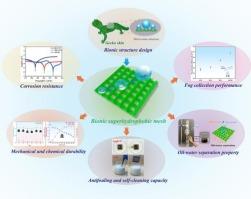仿生多功能铜网,自清洁,油/水分离和雾收集
IF 9
1区 工程技术
Q1 ENGINEERING, CHEMICAL
引用次数: 0
摘要
随着原油泄漏的回收成为碳中和战略的重要组成部分,以及全球淡水资源的日益稀缺,实现油水混合物的有效处理和水资源的可持续利用是一个迫切需要解决的科学挑战。因此,本研究利用壁虎皮肤的超疏水和自清洁特性,将线切割加工(WEDM)技术与原位生长策略相结合,构建多功能超疏水仿生铜网(MS-BS)。本设计在自洁性、机械化学稳定性、耐腐蚀性、油水分离能力、集雾效率等方面综合性能突出。MS-BS的水接触角(CA)为161.5°,滚动角(RA)为0.1°,具有良好的防污和自清洁能力。经过200次(1.63 KPa)的磨损循环后,MS-BS仍保持疏水性(CA = 140°),并表现出良好的耐不同pH溶液的性能,证实了优异的机械和化学稳定性。此外,MS-BS用于油水混合物的高效分离,最高分离效率约为98.5%,最高分离通量为160,000 L·m−2·h−1,即使经过50个操作循环,分离效率仍保持在96%。此外,MS-BS提供了一种潜在的雾收集策略,雾收集效率为3386 mg·cm−2·h−1,是普通铜片的12.7倍。这种仿生集成表面设计策略为开发高性能环境治理材料提供了一条新的研究路径,具有广阔的应用前景。本文章由计算机程序翻译,如有差异,请以英文原文为准。

Bionic multifunctional copper mesh for self-cleaning, oil/water separation and fog collection
With the recovery of crude oil leakage becoming an integral part of the carbon neutrality strategy and the increasing scarcity of global freshwater resources, achieving efficient treatment of oil-water mixtures and sustainable access to water resources is a pressing scientific challenge that needs to be addressed urgently. Therefore, this study combines wire electrical discharge machining (WEDM) technology with an in-situ growth strategy to construct a multifunctional superhydrophobic bionic copper mesh (MS-BS) inspired by the superhydrophobic and self-cleaning properties of gecko skin. This design exhibits outstanding comprehensive performances in terms of self-cleaning, mechanical and chemical stability, corrosion resistance, oil-water separation ability, and fog collection efficiency. The MS-BS demonstrates good antifouling and self-cleaning capacity with a water contact angle (CA) of 161.5° and a rolling angle (RA) of 0.1°. After 200 abrasion cycles (1.63 KPa), the MS-BS remains hydrophobic (CA = 140°) and shows good resistance to different pH solutions, confirming superior mechanical and chemical stability. In addition, the MS-BS is applied for highly efficient oil-water mixture separation, achieving a maximum separation efficiency of about 98.5 % and the highest separation flux of 160,000 L·m−2·h−1, and even after 50 operation cycles, it maintains 96 % separation efficiency. In addition, the MS-BS provides a potential fog collection strategy, showing a fog collection efficiency of 3386 mg·cm−2·h−1, which is 12.7 times greater than that of the ordinary copper sheet. This bionic integrated surface design strategy presents a new research path for developing high-performance environmental governance materials and holds broad application prospects.
求助全文
通过发布文献求助,成功后即可免费获取论文全文。
去求助
来源期刊

Separation and Purification Technology
工程技术-工程:化工
CiteScore
14.00
自引率
12.80%
发文量
2347
审稿时长
43 days
期刊介绍:
Separation and Purification Technology is a premier journal committed to sharing innovative methods for separation and purification in chemical and environmental engineering, encompassing both homogeneous solutions and heterogeneous mixtures. Our scope includes the separation and/or purification of liquids, vapors, and gases, as well as carbon capture and separation techniques. However, it's important to note that methods solely intended for analytical purposes are not within the scope of the journal. Additionally, disciplines such as soil science, polymer science, and metallurgy fall outside the purview of Separation and Purification Technology. Join us in advancing the field of separation and purification methods for sustainable solutions in chemical and environmental engineering.
 求助内容:
求助内容: 应助结果提醒方式:
应助结果提醒方式:


